Pump Handbook by Igor J. Karassik, Joseph P. Messina, Paul Cooper, Charles C. Heald - 3rd edition
Подождите немного. Документ загружается.

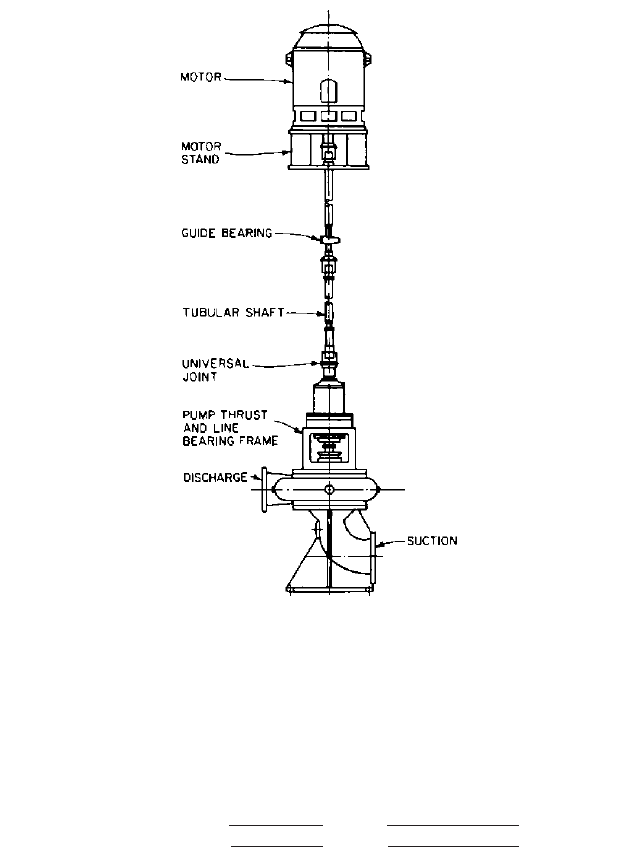
6.188 CHAPTER SIX
FIGURE 23 Vertical pump with flexible shafting (Flowserve Corporation)
where w weight (force) of shaft per unit length, lb/in (N/m)
L length between bearing supports, in (m)
E Young’s modulus, lb/in
2
(N/m
2
)
I moment of inertia, in
4
(m
4
)
Knowing the natural deflection of the shaft, it is possible to calculate the first critical
speed from the equation:
which expresses critical speed directly in revolutions per minute of the rotating shaft.
In practice, the critical speed should be placed well away from the operating speed of
the shaft. Actual operating conditions, such as imbalance and clearance in bearings and
couplings, tend to reduce the critical speed from its theoretical value.The designer has sev-
eral options from which to choose to attain the desired critical speed: (1) vary the shaft
diameter, (2) use tubular shafting to increase stiffness and reduce deflection, and (3) vary
the bearing span.
Varying the diameter of the shaft has a dramatic effect on shaft deflection because the
deflection decreases inversely with the cube of the diameter. The weight of the shaft will
N
crit
187.7
A
1
y 1in inches2
946
A
1
y 1in millimeters2
6.3.1 PUMP COUPLINGS AND INTERMEDIATE SHAFTING 6.189
increase proportionately to the square of the diameter and may consequently impose
excessive loads on hearings.When this is the case, tubular shafting may be substituted for
solid shafting.The ratio I/w is much higher for a tubular shaft than for a solid shaft of the
same diameter, so the shaft deflection is again reduced and critical speed increased.
The bearing span may be varied when the size and weight of a single length is broken
into sections, with a single engagement coupling used to connect each section and acting
as a hinge joint. A self-aligning bearing is placed on each section immediately adjacent to
the coupling. Each section may then be treated as an individual shaft, which will result in
a substantial reduction in shaft size. The rigidity of the support at each hearing must be
taken into consideration when calculating the critical speed of the shaft.
Dynamic Balance Drive systems that operate at high speeds and connect two widely sep-
arated shafts must be given special consideration with regard to dynamic imbalance. Care
must be taken to ensure that the long, slender shaft used in such systems is not bent,
either in manufacture or in installation. These systems quite often require shafting that
has been dynamically balanced after manufacture to compensate for these normal errors.
REFERENCES AND FURTHER READING_________________________________
1. American Gear Manufacturers Association, ANSI/AGMA 9000. “Flexible Couplings
—
Potential Unbalance Classification.”1500 King Street, Suite 201, Alexandria, VA, 22314.
2. American Petroleum Institute Standard 610.“Centrifugal Pumps for Refinery, Heavy
Duty Chemical, and Gas Industry Services.” 8th ed., 1220 L Street, Washington, DC
20005, 1995.
3. American Petroleum Institute Standard 671. “Special Purpose Couplings for Petro-
leum, Chemical, and Gas Industry Services.” 3rd ed., 1220 L Street, Washington, DC
20005, October, 1998.
The use of fluid (hydraulic pump and motor) power transmission systems to drive water
pumps is a relatively recent development. The first units of any size were first marketed
in the late 1960s and early 1970s and were utilized primarily for construction dewatering
purposes because they can be driven by diesel engines or electric motors located well away
from construction site cave-ins without the inconveniences of priming and suction hoses
and with no limitation on suction lift or capacity (Figure 1).
COMPONENTS_______________________________________________________
A typical unit consists of a submersible axial-flow water pump with a hydraulic motor
mounted in the pump bowl (Figure 2).The thrust bearings, shaft, and hydraulic motor are
all sealed to operate under water. The hydraulic motor is driven by oil fed from a hydraulic
pump under a pressure of approximately 2500 lb/in
2
(170 bar
1
). Water flowing past the
hydraulic motor acts as a heat exchanger and keeps the system cool. Plumbing extends
from the hydraulic motor out through the pump bowl and connects to the hydraulic oil con-
duits leading to the hydraulic pump driver. Quick-coupling hose connections are generally
supplied on each end of the hydraulic hoses. The quick couplings contain spring-loaded
hall valves that prevent the oil from leaking from either side when the couplings are dis-
connected (Figure 3).
The hydraulic pump is driven by the prime mover, which is generally a diesel engine
or electric motor. The hydraulic conduits may be steel-reinforced rubber hoses or steel pipe
or a combination of both (Figure 4). Sometimes it is desirable to utilize a combination of
steel pipe and flexible hose as the conduits. This is particularly true when the drive units
6.3.2
HYDRAULIC PUMP AND
MOTOR POWER
TRANSMISSION SYSTEMS
DAVID ELLER
6.191
1
1 bar 10
5
Pa.
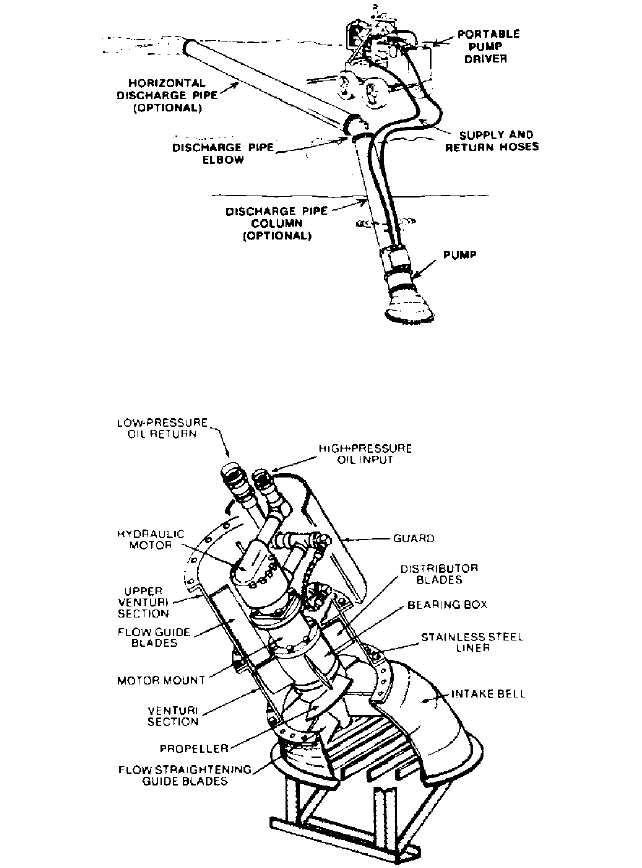
6.192 CHAPTER SIX
FIGURE 1 Typical portable hydraulically driven water pump with diesel prime mover (M & W Pump)
FIGURE 2 Interior of a hydraulically driven axial-flow water pump (M & W Pump U.S. Patent No. 3, 907, 463,
other patents pending)
are to be located a considerable distance from the water pump. When steel pipe is used, it
is highly desirable to weld all joints.After welding, the pipes should be thoroughly cleaned
and tested up to maximum expected operating pressures and inspected for leaks. The
pipes should then be painted with an asphalt-base enamel or epoxy, depending upon the
surrounding environment.
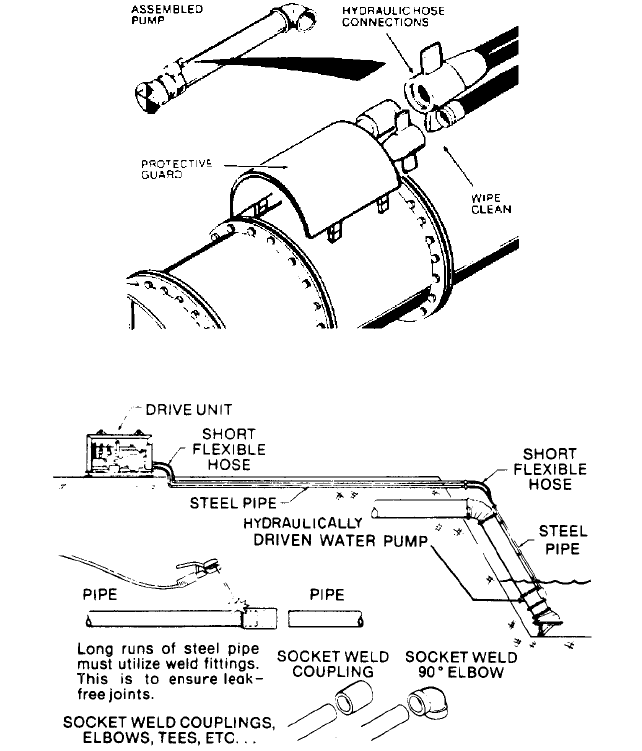
6.3.2 HYDRAULIC PUMP AND MOTOR POWER TRANSMISSION SYSTEMS 6.193
FIGURE 3 Quick couplings are used to fasten hydraulic hoses to the water pump
FIGURE 4 For permanent installation, steel pipes with welded joints are generally used for the hydraulic oil
conduits instead of hoses.
Hydraulic pump and motor drives can be adapted to centrifugal volute pumps. Figure
5 illustrates a portable nonclogging-impeller trash or sewage pump so driven.
ADVANTAGES _______________________________________________________
Although the original users of hydraulically driven water pumps were contractors, farm-
ers, and open pit miners using mostly portable pumps, the system described here offers the
advantage of permanent pump stations, such as might be used for municipal storm
drainage (Figure 6) or massive irrigation or drainage works.
The system is very simple. The power source can be located close to the pump or in a
more accessible or protected area. Other advantages include the ability to vary the speed
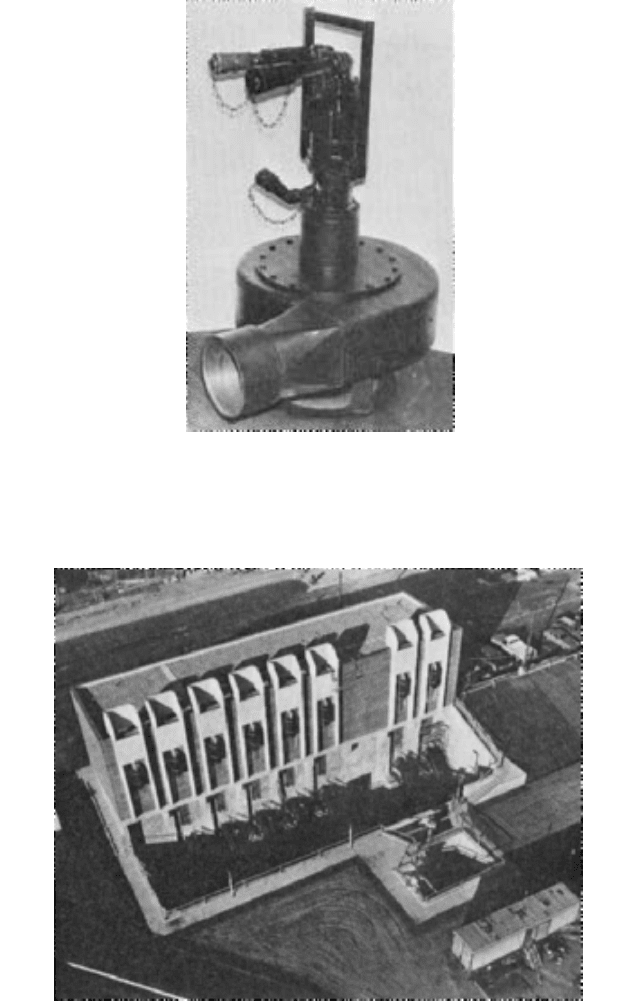
6.194 CHAPTER SIX
FIGURE 5 Portable centrifugal volute trash pump driven by hydraulic motor (M & W Pump)
FIGURE 6 A 350,000-gpm (79,500-m
3
/h) municipal pump station for combination storm drainage and final
sewage effluent (M & W Pump)
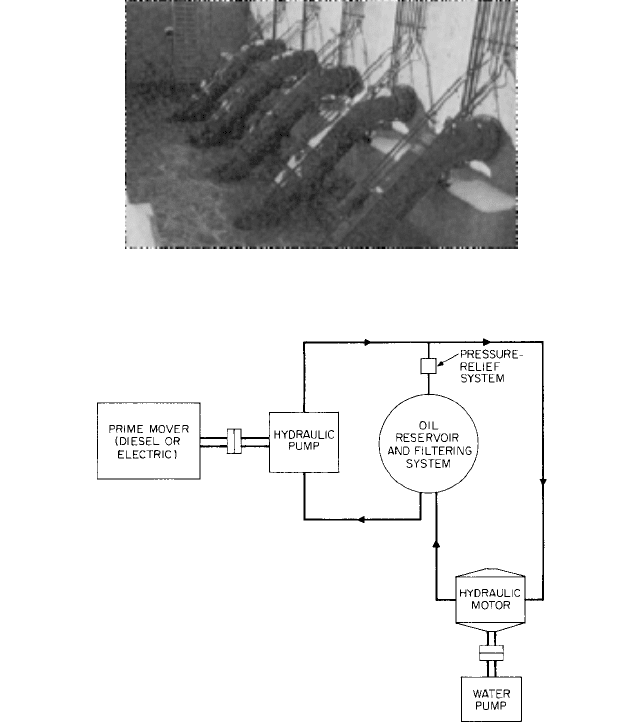
6.3.2 HYDRAULIC PUMP AND MOTOR POWER TRANSMISSION SYSTEMS 6.195
FIGURE 7 Five 42-in (107-cm) double-staged hydraulically driven water pumps with design flows automatically
varying from 0 to 50,000 gpm (0 to 11,550 m
3
/h) (M & W Pump)
FIGURE 8 Hydraulic drives are much simpler than other types of electromechanical equipment and provide a
wide speed range, variable-speed and reversing capability, and shock resistance at a relatively low cost.
of the water pump by regulating the amount of hydraulic oil sent to the motor, the ease of
automation for automatic or remote control, and safety because there is no high-voltage
electricity in the water (Figures 7 and 8).
FIXED VERSUS VARIABLE FLOWS ______________________________________
A fixed displacement hydraulic pump is used to drive the fixed-displacement hydraulic
motor when a fixed water pump flow is desired. The drive shaft of a fixed-displacement
vane pump (see Figure 9) is keyed to a rotor and revolves with it. Rectangular varies fit
into slots in the rotor. As the rotor turns, the vanes are forced out by centrifugal force to
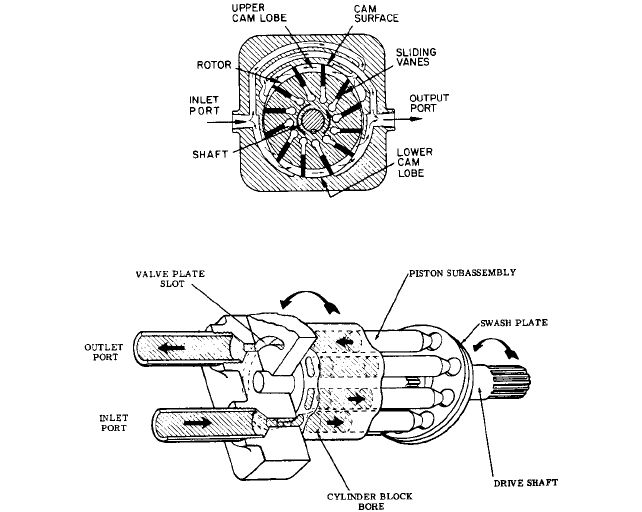
6.196 CHAPTER SIX
FIGURE 9 Principle of fixed-displacement balanced-vane pump
FIGURE 10 Principle of variable-displacement piston pump
make continuous contact with the cam surface. Because of the kidney shape of the cam sur-
face, the space between a vane passing top dead center and the vane ahead of it starts clos-
ing down, increasing pressure and forcing oil out through the outlet port. Simultaneously,
the vanes on the pump inlet side are passing through the cam kidney-shaped area, which
is increasing in size, thus creating a vacuum that pulls oil in through the pump inlet.
When it is desirable (as for final sewage effluent pumping), water pump flow rate can
be easily varied through a large range by regulating the amount of oil going to the
hydraulic motor in the water pump bowl. Because the hydraulic motor has a fixed dis-
placement, its speed is a direct function of the amount of oil supplied to it by the hydraulic
pump connected to the prime mover. Assuming a constant-speed prime mover, the rate of
oil flow can be changed easily by utilizing a variable-displacement piston hydraulic pump
(Figure 10). In this type of pump, the pistons are moved into and out of the cylinder block
by a swashplate rotating cam whose angle can be changed either manually or automati-
cally. When the cam is set at zero angle, the piston does not move and no oil is pumped.As
the cam angle is increased, the pistons begin to reciprocate and oil is pumped. The amount
of oil pumped is directly related to the angle of the swashplate. For automatic systems, the
swashplate angle can be regulated by a servo-control valve attached to the hydraulic
pump. This valve is simply an apparatus that converts an electric signal to a mechanical
force. A typical system would utilize a 0- to 20-mA signal coming from a sensor in the
pump sump.
The sensor could be a sonic, air bubbler, or float device measuring the wet-well sump
level and sending a proportional electric signal back to the servo-control valve on the
hydraulic pump. If the sump level is rising, for instance, the electric signal may increase,
which would cause the servo to stroke the hydraulic pump swashplate to a greater angle,
increasing the amount of oil being pumped. This in turn would speed up the hydraulic
motor and the water pump propeller, and the water pump flow would increase. Thus a rel-
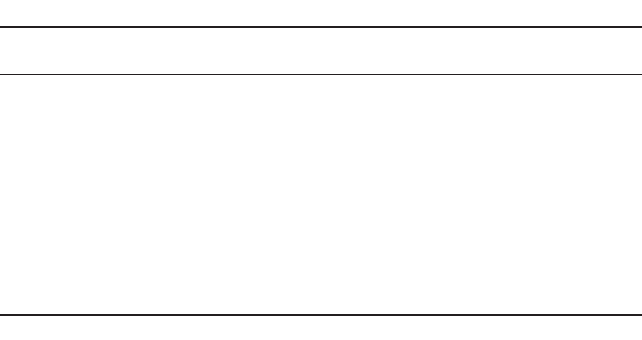
6.3.2 HYDRAULIC PUMP AND MOTOR POWER TRANSMISSION SYSTEMS 6.197
atively small water-pump sump can be utilized, and pumped water outflows can be regu-
lated to match highly varying gravity inflows.
EFFICIENCY_________________________________________________________
The main criticism of hydraulic power transmission systems for water pumps is that
power is lost through the hydraulic system. There is obviously a power loss in the
hydraulic pump, the hydraulic motor, and the plumbing. However, when evaluating effi-
ciencies against those of other types of power transmission systems, such as gears, belts
and pulleys, and direct-connected shafts, it is important to make meaningful comparisons.
Water pump manufacturers typically publish performance curves for their wet-pit
pump bowls only, and these curves do not include power losses for any type of power trans-
mission system. This is done because the pump manufacturer does not know the shaft
lengths for all possible extended-shaft pumps.Therefore, there is no way the manufacturer
can include the losses for the shaft, bushing and bearing supports, couplings, and other
transmission parts. Consequently, a user must add to the evaluation the losses resulting
from the extended shafting and other transmission parts.
For example, a typical extended-shaft pump may have a column shaft 30 ft (9 m) long.
An additional power requirement of 10 to 15% above that of the pump alone would not be
unusual for an extended-shaft pump with a gear or belt drive. By comparison, a hydrauli-
cally powered pump would typically have a power transmission loss of 20 to 25%
—
or in
other words, would require 10 to 15% more power than an equivalent extended-shaft
pump. Thus, a hydraulically powered pump may require, for example, a 30-hp (22-kW)
motor rather than a 25-hp (19-kW) motor or diesel prime mover. However, the additional
cost of this larger motor should be weighed against the savings in civil works costs and
engineering and installation time and the savings resulting from the versatility and auto-
matic operation possible with the hydraulic system.
AVAILABLE SIZES____________________________________________________
Hydraulic pump and motor transmission systems are available for almost any speed out-
put, from 100 to 3000 rpm for power outputs up to 500 hp (370 kW). For larger power dri-
ves, speed selection is more limited.
Table 1 illustrates readily available standard pump and hydraulic drive sizes from one
manufacturer.
TABLE 1 Standard pump sizes readily available with hydraulic drives
Discharge diameter, Capacity range, Total head range,
in (cm) gpm (m
3
/h) ft (m)
a
4 (10) 111,475
—
1,025 11,(110
—
280) 18
—
10 (2
—
12)
6 (14) 111,700
—
1,450 11,(160
—
330) 18
—
50 (5
—
15)
8 (20) 111,400
—
2,300 11,(820
—
520) 15
—
23 (1.5
—
7)
12 (89) 112,500
—
4,000 11,(570
—
910) 15
—
45 (1.5
—
14)
16 (41) 114,000
—
8,000 11,(910
—
1,800) 15
—
28 (1.5
—
7)
18 (46) 115,000
—
9,000 1(1,100
—
2,000) 18
—
45 (5
—
14)
20 (51) 117,000
—
12,000 1(1,600–2,700) 15
—
20 (1.5
—
6)
24 (61) 112,000
—
17,000 1(2,700
—
3,900) 15
—
22 (1.5
—
7)
30 (76) 123,000
—
27,000 1(5,200
—
6,100) 15
—
22 (1.5
—
7)
36 (91) 124,000
—
35,000 1(5,400
—
7,900) 15
—
19 (1.5
—
6)
42 (107) 145,000
—
53,000 (10,000
—
12,000) 15
—
16 (1.5
—
5)
60 (152) 100,000
—
120,000 (23,000
—
27,000) 15
—
16 (1.5
—
5)
a
Most units can be double-staged to accomplish twice the heads shown.

Pump
Controls
AND
Valves
W. O’Keefe
C•H•A•P•T•E•R•7
